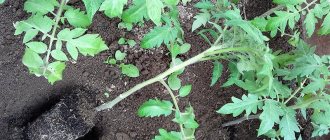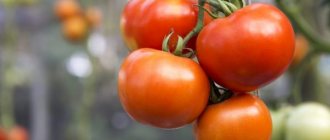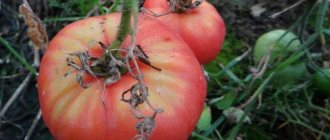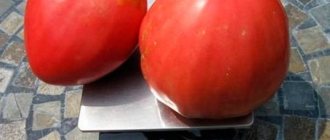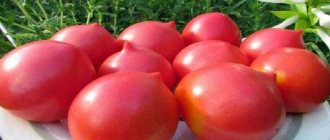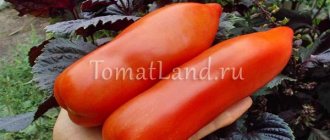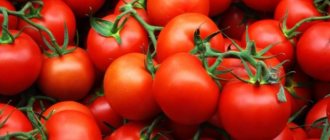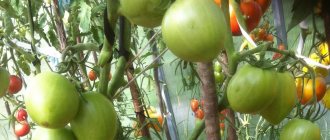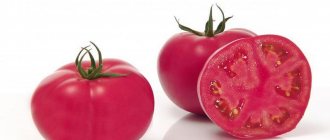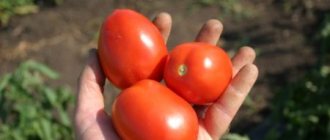Tomato Stresa F1 is a beautiful hybrid with good taste and excellent presentation. Ordinary gardeners and farmers value it for its high yield and immunity to disease, thanks to which they can save time on preventive treatments.
| Height | Landing location | Ripening time | Fruit color | Fruit size | Origin | Fruit shape |
| Tall | Greenhouse | Mid-early | Reds | Average | Hybrid | Flat-round |
Origin of the Stresa tomato variety
The Stresa variety was bred by Russian breeding scientists. The main purpose of tomatoes is growing in unprotected soil, under film covers and in a greenhouse.
Description of the variety
An indeterminate, moderately spreading bush grows up to 1.5 meters in height. The review variety is a mid-early hybrid. The number of leaves on the plants is moderate, the fruits ripen in clusters of 6 pieces.
Main characteristics of ripe Stresa tomatoes:
- Flat-round shape;
- Noticeable ribbing at the stalk;
- Medium sizes;
- Thin dense skin;
- The fruits are not prone to cracking;
REFERENCE: When processed, tomatoes produce tasty and healthy tomato juice.
- Ripe tomatoes are bright red;
- Juicy, moderately dense pulp;
- A small number of seeds;
- The average weight of ripe tomatoes is 200 grams and above;
- Pleasant sweet taste with barely noticeable sourness;
- Versatility in use;
- Good presentation.
Description and characteristics of the variety
The cultivar has indeterminate tall bushes up to 170 cm. The fruits are collected in clusters of about 6 tomatoes each. They ripen 110-115 days after the sprouts hatch. The shape of the tomatoes is flat-round with slight ribbing, they are leveled, almost the same size, weighing 180-200 g. The skin is bright red, smooth and glossy. The pulp has a good taste, considering that it is a hybrid, and is dense.
Tomatoes can be used for processing into juices and pastes, pickling, canning, fresh salads and preparing various dishes.
You cannot prepare hybrid seeds for planting, as they will not produce plants with the required qualities.
History of selection
The Stresa F1 tomato was created in Russia specifically for greenhouse cultivation. In areas with a warm climate, sowing in open beds is allowed.
Tomatoes: advantages and disadvantages
The main advantages of Stresa tomatoes:
- Excellent productivity;
- High taste qualities of fruits;
- Ripe tomatoes are stored at room temperature for a long time;
- Immunity to most diseases;
- Tomatoes are not prone to cracking;
- Possibility of transporting crops over long distances.
The best varieties of meaty tomatoes:
The disadvantages of the review variety include the following points:
- Tall plants need to be tied to supports or trellises;
- Bushes need to be pinched;
- Tomatoes are sensitive to fertilizing.
Characteristics
The Stresa tomato variety was bred by Russian breeders and is intended for closed ground: film greenhouses or glazed greenhouses. In regions with warm climates, planting in open beds is possible. The safety of the collected fruits is good, transportation is possible.
Tomatoes are medium-sized, weighing 200 g or more, flat-round, with noticeable ribbing at the stalk. During the ripening process, the color changes from light green to bright red. The skin is thin, the tomatoes do not crack. The pulp is moderately dense, juicy, low in seeds. The taste is very pleasant, not watery, sweet with barely noticeable sourness.
The fruit is a salad variety, perfect for preparing various dishes, from appetizers to soups. Tomatoes can be eaten fresh and produce a delicious, rich juice.
You can compare the weight of the fruits of this variety with others in the table:
| Variety name | Fruit weight |
| Stresa | 200 grams |
| Newbie | 85-105 grams |
| Dusya Krasnaya | 150-350 grams |
| Cosmonaut Volkov | 550-800 grams |
| Garlic | 90-300 grams |
| Tamara | 300-600 grams |
| Perseus | 110-180 grams |
| Sunrise | 50-100 grams |
| Funtik | 180-320 grams |
| Marina Grove | 145-200 grams |
| Siberian early ripening | 60-110 grams |
Growing tomatoes
Hybrid "Stresa" is grown by seedlings.
How to prepare seeds?
For sowing, it is necessary to select only dense and whole seeds that are not damaged by fungi and pests. Planting material should be disinfected in a weak solution of potassium permanganate.
Sowing seed material
Seeds are planted for seedlings no earlier than mid-March. Planting material does not need additional treatment with growth stimulants, since the manufacturer has taken care of this in advance.
To plant seeds, you need light, nutritious soil. A mixture of garden soil with peat or humus is perfect.
The seeds are planted to a depth of 1.5 to 2 cm. The soil with planting material is sprayed with warm, settled water and covered with film. Containers with future seedlings should be in a warm place.
After the first shoots appear, the film is removed and the room temperature is reduced to 16 degrees Celsius for 5-7 days. Then the temperature is raised again to 20 degrees.
The seedlings should be in a brightly lit room.
After the first true leaves appear on the sprouts, they are picked into separate containers. At the same time, the seedlings are fed with complex mineral fertilizers.
IMPORTANT: For greater nutritional value, the soil is enriched with superphosphate or sifted wood ash.
Rules for planting seedlings
The seedlings are transferred to a permanent place of growth in the second half of May. It should be remembered that the seedlings should not outgrow - they gain the bulk of the green mass already in the beds.
Before planting, the soil on the site is thoroughly loosened and fertilized with humus. Planting scheme - no more than 3 tomatoes per 1 sq. meter.
Seedlings should be watered sparingly, in the evening with warm, settled water.
How to water tomatoes correctly
Proper watering, loosening, and fertilizing the bushes helps to grow abundant tomato harvests.
- You need to water the tomatoes with warm water at about 18-20 degrees, at least 15 degrees.
- It is better if watering is drip. If watering is not drip, then water consumption depends on the age of the plant: from 5 to 10 liters at the root every 8-12 days.
- Watering should be alternated with loosening the soil under the plant bushes. This will protect the planting from the development of fungal diseases and ensure optimal aeration of the bushes.
- Tomatoes "Stresa F1" require humidity in the range of 65-70% for normal pollination and fruit set. High air humidity, in addition to the development of fungus, leads to pollen gluing and pollination of flowers does not occur. Low humidity causes the pollen to scatter and not reach the pistil; in this case, pollination also does not occur and the yield of the bushes decreases.
See also
Characteristics and description of the tomato variety Amur TigerRead
Bush care
Basic rules for caring for Stresa tomatoes»:
- Regular moderate watering;
- Carefully loosening the soil in an area planted with tomatoes;
- Weeding and weed removal;
- Feeding with organic matter and nutritional mineral complexes.
IMPORTANT: Stepchildren are removed after the formation of the fifth brush.
The bush is usually formed into 1 or 2 stems.
It is better to remove all deformed flowers - this procedure stimulates the formation of new ovaries and the formation of larger fruits.
For better access of oxygen to the stem and root system, it is recommended to remove the lower leaves.
The bush is attached to a trellis or support. As the tomatoes ripen, the branches are also tied to pegs.
Specifics of cultivation and description of the tomato variety Stresa f1
Tomato Stresa F1 was bred by Russian breeders specifically for cultivation in greenhouses. These tomatoes are intended for planting indoors. The exception is regions with warm climates. The variety is loved by vegetable growers and farmers, as its yield is quite high.
Description of Stresa tomato
Below are the general characteristics and description of the variety:
- Planted tomatoes ripen in 110-115 days.
- The fruits grow quite large, the weight of each tomato reaches 200 g or more.
- Planting of seeds begins in the second half of March.
- Many people prepare seeds before planting, but you don’t have to do this, since the manufacturer treats them with a stimulating composition.
- Tomatoes have a bright red color, thin but dense skin that is not prone to cracking.
- Tomatoes have few seeds, and the flesh is dense. The fruit tastes slightly sour. Tomatoes of this variety contain little water.
- Stresa tomatoes make very tasty dishes, as well as tomato juice or sauce with pulp.
Specifics of growing the variety
A mixture of soil with humus and peat is ideal for planting, and for greater nutrition it is recommended to add wood ash or superphosphate. The seeds are planted to a depth of 2 cm. Instead of watering, the soil is sprayed. It is worth remembering that frequent spraying will lead to rotting of the seeds.
The container with the planted seeds should be covered with film and left in a warm place until the first shoots.
After the sprouts appear, the film is removed and the container is moved to a bright and warm place. For watering, it is better to use a spray bottle instead of a watering can. You can fertilize seedlings only after 2 or 3 true leaves appear. Somewhere from mid-May, the plant will finally get stronger and will be ready to be transplanted to a permanent location.
No more than 3 bushes are planted per 1 m². Stresa tomatoes have high yields. Over 25 kg of fruits are harvested from 1 m².
The bush must be formed. This is done by plucking the stepsons, which are removed after the 5th brush. They are usually formed into 2 stems. Pinching stimulates the formation of new ovaries, which increase productivity.
It is very important to tie up plants. To do this, you need to install supports and carefully, trying not to damage the brushes, tie up the branches. Pieces of cut fabrics are used as garters.
Diseases and pests
Since "Stresa" is a first-generation hybrid, it has strong immunity to a large number of diseases. Thus, the variety is resistant to such dangerous diseases:
- Fusarium;
- Verticillium;
- Tobacco mosaic virus.
When growing tomatoes in greenhouses, for preventive purposes, you should regularly ventilate the room, loosen the soil, and promptly remove weeds.
To prevent the appearance of root rot, the ground under the bushes must be mulched with peat or straw.
When the first signs of late blight are detected, plants need to be treated with preparations with a high copper content.
Insect pests are controlled using insecticides and folk recipes. During fruiting, the use of chemicals is prohibited, so they can be replaced with folk recipes - a decoction of celandine, chamomile, and onion peels. Spraying the plantings with a weak solution of manganese also helps get rid of insects.
When slugs appear, tomatoes are sprayed with an aqueous solution of ammonia.
How to grow tomatoes
Hybrid Stresa f1 is grown in protected ground using standard methods. The soil and greenhouses are prepared in the fall. In the spring, they are re-loosened and fertilized with humus. Indeterminate plants need pinching, staking, moderate watering and the application of organic and mineral fertilizers.
Landing
The strengthened seedlings are transferred to a permanent place in mid-May. The soil is dug up in the fall, plant debris is removed along with the roots and a bucket of humus is added per 1 m². At the beginning of spring, the soil is loosened and fertilized with humus - 10 liters per square meter.
Holes 20 cm deep are dug in a checkerboard pattern every 40 cm. The distance between the rows is 70 cm. Cool boiling water is poured into each hole, a handful of wood ash and a tablespoon of superphosphate are added. Seedlings are moistened abundantly with warm water and planted in holes.
After planting, the soil is covered with black agrofibre to prevent the growth of weeds, the spread of fungi and bacteria, and reduce labor costs for caring for tomatoes. Instead of synthetic fiber, straw, peat, sawdust, and pine needles are used.
The bushes are formed into two stems by removing young shoots after the fifth cluster and tied to high wooden supports or a trellis. The procedure stimulates the formation of ovaries and increases productivity.
Tomatoes prefer moderate watering with warm rain or settled water at the root in the morning or evening. Installing a drip irrigation system will help optimize plant care.
Young bushes require about 5 liters of water, adults – 10 liters. Watering frequency is once every 10–12 days.
The Stresa hybrid needs regular feeding with organic and mineral compounds. During the growing season, plants are fertilized 3-4 times. The first fertilizing with organic matter is carried out two weeks after planting. An infusion of chicken manure (20 g per 10 liters of water) or mullein (1 liter of infusion per 10 liters of water) is suitable for this. Ready-made organic fertilizers are popular: “Pixa”, “Vermix”, “Ripen-ka”, “Reliable”.
14 days after adding organic matter, the bushes begin to be fed with mineral complexes during the flowering period, the formation of ovaries and at the beginning of fruiting: “Kemira”, “Universal”, “Rastvorin”. Their main advantage is their balanced composition, eliminating the need to prepare the mixture yourself. The manufacturer indicates on the packaging the consumption and frequency of use.
Features of growing in closed and open ground
When cultivating Stresa tomatoes in a greenhouse, maintain an air humidity level of 65–70%. Excessive humidity causes pollen to stick together. When humidity is low, pollen scatters and does not reach the pistil. In both the first and second cases, pollination is difficult or does not occur at all.
Despite the manufacturer’s recommendations, in the southern regions the crop is also grown in open areas. The agricultural technology of tomatoes is no different from growing them in greenhouses. The culture withstands heat and cold and rarely gets sick. At the same time, yield indicators decrease, but the taste and presentation of the fruit remain at a high level.
Diseases and pests
The hybrid has strong immunity to tomato mosaic virus, cladosporiosis, fusarium, verticillium and root-knot nematode.
To prevent late blight (brown spots on stems, leaves, tomatoes, whitish coating on the back of the leaves), the bushes are sprayed with “Fitosporin”, a whey solution (100 ml per 1 liter of water), the soil is mulched with sawdust, hay or pine needles, and an optimal level of humidity is maintained. in greenhouses.
The preparations “Confidor”, “Borey”, “Flumite”, “Iskra”, “Aktarra”, “Epin”, “Commander”, “Decis Profi” will help get rid of aphids, spider mites, whiteflies, Colorado potato beetles, and gnawing cutworms.
Slugs are collected by hand at night or the plants are sprayed with ammonia solution (4 tablespoons per 10 liters of water).
Productivity
The hybrid "Stresa" is famous for its high yield. From 1 sq. meters, at least 25 kg of fruit are collected.
Which regions are best to grow in?
Review variety tomatoes are grown in many regions of Russia. In the south, tomatoes are planted in unprotected soil. In the central regions and middle zone, the hybrid is grown in greenhouses and greenhouses.
How to grow seedlings
The crop is grown through seedlings. Sowing work begins in the second ten days of March, 60–65 days before transferring to closed ground.
Preparing the soil and sowing seeds
Seeds do not need to be treated with potassium permanganate or soaked in growth stimulants before sowing. This is what they do in production.
To identify empty grains, a calibration method is used. The seeds are soaked for 10 minutes in a saline solution (1 tsp per glass of water at room temperature). Poor quality material will float to the surface; it is not used for sowing. The seeds remaining at the bottom of the glass are washed with warm running water.
Soil for growing seedlings is prepared from equal parts of turf, peat and river sand with the addition of superphosphate (40 g per bucket of soil mixture). They also use ready-made substrate in bags for growing seedlings of peppers and tomatoes. Such soil is already enriched with nutrients.
Before use, the soil is disinfected in an oven, steamer, and treated with a solution of potassium permanganate or “Fitosporin M”. The procedure prevents the development of bacteria and fungi in the soil.
For sowing seeds, cassettes, boxes, plastic trays, pots, juice or milk tetrapacks are used. The seeds are placed in moist soil to a depth of 2 cm with an interval of 2–3 cm. A film is pulled over the top to create greenhouse conditions and the containers are taken to a dark, warm place. The seeds hatch after 4-5 days at a temperature of +25 °C.
Care
After the shoots appear, the film is removed and the containers are taken to a lighted place. The duration of daylight should be at least 15–16 hours. To prevent seedlings from stretching out and gaining strength faster when there is a lack of sunlight, fluorescent lamps are installed above them.
Seedlings do not like overwatering, so instead of a watering can, use a spray bottle.
At the stage of 2-3 leaves, seedlings are planted in individual pots made of plastic or peat. A week after picking, the seedlings are fed once with Effecton or Agricola.
At home it is easy to prepare universal foliar and root feeding:
- 20 g superphosphate;
- 10 g of potassium sulfate;
- 5 g urea.
Reference. A week before transferring to the greenhouse, the seedlings are taken out to the balcony every day for half an hour for hardening.
Factors influencing productivity increase
A competent agronomic approach to the cultivation of tomato varieties affects the quantity and quality of the resulting harvest.
- Orientation of the direction of planted rows from east to west in indoor growing conditions, and from north to south in open ground. This kind of simple method helps to get the maximum amount of ultraviolet radiation (sun rays).
- The extra light picking of flowering bushes helps the self-pollination process speed up. This ceremony helps in a closed greenhouse, where there is no wind and insects.
- To die and not rise during the flowering time of the clusters, it is recommended to spray with a weak solution of boric acid, which promotes good fruit set and growth, and stimulates new growth points of inflorescences. Just dissolve 10 g of powder in 10 liters of water.
- Periodic hilling provides rational access of air to the root system of the bush, which contributes to its strengthening, and adequately, to an increase in vegetative mass and the formation of inflorescences.
- Mulching the soil helps retain moisture and protects the roots from stripping during watering or heavy rains if the eggs are raised outdoors. The rows can be filled with straw and compost, grass clippings, peat and sawdust.
- Necessary and timely brushing of the shoots, formation of the bush and tying on supports and crossbars hold the growing testes with fruits, preserving the trunk from fracture and damage from weight, wind or when caring for tomatoes and harvesting.
- Mineral fertilizers and fertilizing with microelements give the plant strength, presence of active vegetation and the formation of clusters with ovaries.
- Removing the lower leaves in contact with the soil prevents rotting near watering and the formation of colonies of mold fungi, leading to damage to the bush.
- Regular watering from the moment of emergence protects tomatoes from premature withering and burning of leaves under the rays of the hot summer sun.
Proper planting and careful rotation guarantee a good harvest. This unpretentious tomato variety is resistant to many diseases and requires more attention than any other type of tomato.
Methods of cultivating seedlings
For the spring - summer growing season, seeds are sown at the end of March directly into the protected soil of a heated glass greenhouse, which saves time on diving and grows a larger number of roots for planting in open space at stable daily air temperatures.
Additional cultivation is possible in special wooden boxes for seedlings or peat pots. To obtain the first harvest in early June, sowing must be done in the last days of February. The seeds do not require additional processing before sowing. In seed boxes or containers, planting can be done in marked furrows with a distance of 1.5 cm between seeds and 3 cm between rows. The planting depth should not exceed 1.5 cm. One seed is placed in pots and cassettes, which gives the plant more advantages for the formation of the root system and uniform growth of leaves on the trunk. Thinning of the sown rows directly into the ground is carried out as the tomatoes grow, with further transplantation to a permanent place for fruit ripening.
To obtain a strong trunk, it is necessary to use additional lighting and maintain stable air humidity at temperatures of 22 - 25 degrees. Feeding is done from the moment two true leaves appear. Liquid organic matter is diluted with water to avoid burns to the root system. It is fertilizers that influence the coloring of leaves from pale green to darker, more saturated colors.
Soviet tomato - description and characteristics of the variety
Description of the large-fruited, early-ripening Strega tomato and growing features
The modern early Strega tomato makes it possible to obtain fresh vegetable products already at the beginning of summer, when the shortage is felt most strongly. The hybrid is distinguished by its friendly yield, which makes it convenient for growing on small farms and in summer cottages. Resistance to adverse weather conditions allows us to recommend these tomatoes for different regions of Russia.
General characteristics of the variety
The bushes are indeterminate, tall, and in greenhouse conditions can reach 1.5 m or more. To obtain high yields per unit area, compacted planting (4-5 plants per 1 m²) and the formation of tomatoes into 1-2 stems is recommended. Under such conditions, the yield of the variety is up to 24 kg per 1 m².
When grown in open ground, the tomato harvest may be slightly smaller (up to 20 kg). The decrease in the number of fruits occurs due to the fact that the last clusters do not have time to form full-fledged ovaries. But even taking into account the losses, Strega tomatoes can be considered one of the highest-yielding hybrids.
The description of the variety by those who planted Strega notes that the plant has strong growth and forms many stepsons. To form a bush, leave 1-2 pieces, but the rest must be removed as they appear.
An overly dense bush can reduce yield.
In order for tomatoes to reduce the formation of green mass, it is recommended to apply nitrogen fertilizers (organic matter) in the fall, and in the summer to limit ourselves to only adding a complex of minerals for flowering and fruiting (phosphorus and potassium).
Strega tomatoes are not susceptible to fungal diseases. But to prevent late blight, part of the lower leaves (up to 1/3 of the height of the bush) should be removed. In well-ventilated plots, tomatoes are practically not affected by this dangerous disease, and even late-harvested unripe fruits ripen well in boxes.
Description of Strega tomato fruits
Hybrid Strega is a beef tomato. This means that the plant produces large, flat-rounded fruits with an average weight of about 300 g. The pulp of such tomatoes contains few seeds.
5-6 fruit tassels grow on the bush. On average, 5 pieces are tied on each of them. fruits that grow evenly and ripen almost simultaneously.
Fruiting is extended; the last fruits in open ground can be collected in early September.
The skin of the fruit is thin but durable. The ovaries do not crack even under unfavorable growing conditions. Reviews from those who grew such tomatoes note the high keeping quality and excellent transportability of ripe fruits. The color of the shell at biological ripeness is bright red.
The pulp has a dense structure, very juicy and meaty. On the cut, the seed chambers are almost invisible. The color is rich, uniform, without light areas. Characteristics of taste merits indicate an increased content of dry substances and sugars: the tomato is sweet with a slight piquant sourness. Those who grew tomatoes in rainy and cold summers note a decrease in taste.
Tomatoes can be processed into juice and sauces. The intense color of the pulp makes it possible to obtain classic tomato juice; lecho or ketchup is made from the boiled pulp. Only fruits cut into slices can be preserved.
How to grow large tomatoes?
Sowing of seed material is carried out no earlier than 2 months before planting. In this case, it will be possible to obtain strong and strong seedlings that are not overgrown. Seeds are sown in common boxes and germinated at a temperature of +25°C. After 2-3 leaves appear, the seedlings dive at a distance of 10 cm from each other. When growing seedlings, the soil should not be allowed to dry out, as this weakens the plants.
Planting takes place in mid-late May. Depending on the method of cultivation, it can be planted in a greenhouse already in the 2nd decade of May, and in open ground when the return frosts have passed.
To prevent blossom end rot, add chalk, fluff or similar material to the soil at the rate of 1 kg per 1 m².
10-14 days after planting, the tomatoes are fed with a solution of nitrogen complex fertilizer (nitrophoska, Kemira Plus and others).
For good formation of flower clusters and the formation of ovaries, 2 fertilizings are carried out with phosphorus-potassium mixtures (Signor Tomato, Crystalon and others).
The first time the nutrient solution is applied when 1 cluster with flowers is formed, and fertilizers are added to the irrigation water again 2 weeks after that.
